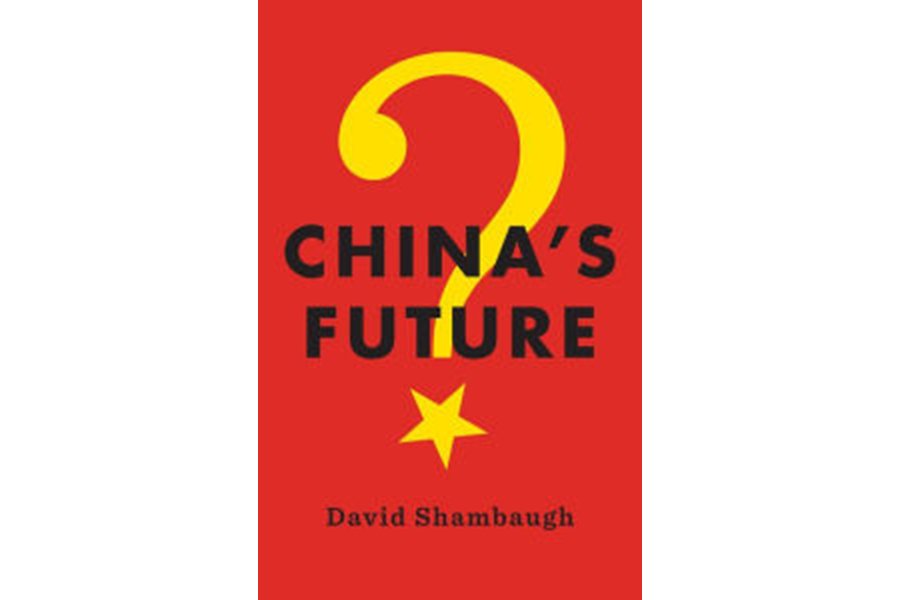'China's Future' predicts the protracted decline of China's Communist Party
Loading...
David Shambaugh, a leading China scholar, has written a book that is sure to cause much discussion among China watchers.
In China’s Future, Shambaugh predicts that the most likely long-term outcome for China’s ruling Communist Party will be one of protracted decline. This marks an evolution from Shambaugh’s earlier views, which suggested that the Party was adapting to multiple challenges, thus ensuring its survival.
Shambaugh also concludes that while China’s President Xi Jinping exudes self confidence, he’s in reality too insecure to pursue needed economic and political reforms. During his first four years in office, Xi has amassed greater personal power than any Chinese leader since Deng Xiaoping, Shambaugh says. And Xi has centralized the institutional power of the Party, the state, and the military in his own hands, says Shambaugh, a political science professor at George Washington University in Washington, D.C. who has written many books on China.
Stalled reforms
According to Shambaugh, no country anywhere has developed a truly modern economy without also democratizing. But President Xi has emphatically rejected this linkage. After many years of rapid economic development, says the author, China has now reached “a critical juncture” in its economic, social, political, environmental, technological and intellectual development.
In Shambaugh’s view, China’s economic reforms have bogged down. For example, China’s much anticipated moves to make state-owned enterprises (SOEs) more competitive and less monopolistic are stalled. The SOEs, he says, are “the epitome of deeply vested interests, with no small degree of corruption deeply embedded within them.” And the links between the SOEs and the state banks that make loans to them is “a form of protectionism that will be difficult to break.”
China, he says, is burdened with excess manufacturing capacity and heavy central, local, corporate, and bank debts acquired as the state tried to maintain the country’s high growth rate. On the social front, the size of the country’s population aged 60 and above is increasing dramatically. But many families have only one child, resulting in a declining labor supply to support economic production and care for the elderly.
On the positive side, according to Shambaugh, the middle class in China now accounts for nearly a third of the population. And that class is expected to grow in size over the next decade. But with growing wealth, China faces a revolution of rising expectations.
Another challenge is widening class differences. China now has more billionaires than any country in the world. But some 80 million people still live below the poverty line on less than $1.00 a day. China is now among the top 10 countries with the world’s highest “Gini coefficient” rankings, a measure of social inequality.
Shambaugh acknowledges that more than 200 million people have been “lifted out of poverty” in China. But some experts would argue that this is mostly the result of the hard work undertaken by the Chinese people themselves, particularly farmers, many of whom in the 1980s began flocking into the cities to work in low-wage factories.
Need for an innovative economy
China’s economy remains “an assembly and processing economy, not a creative and innovative one” says Shambaugh. “Innovation is the key test for China,” he says, and it’s cited as such in Chinese documents and leaders’ speeches. One sign of China’s failure to create an innovation economy is its “rampaging theft of intellectual property.”
Much will depend on changing China’s higher education system, but the author shows why that will not be easy to do. One of the strongest sections of Shambaugh’s book deals with China’s education system, which the author knows well. Higher education should be “the key incubator of creativity and new inventions,” according to Shambaugh. “Yet education is, and will likely remain, one of the main bottlenecks holding back China’s future developments,” he says.
Shambaugh acknowledges that higher education in China over the past two decades has become “much more available to millions who could never dream of a college education before.” But persistent problems afflicting the higher education system include, among others, too close a relationship between universities on the one hand and the Communist Party and government on the other.
It’s a system that emphasizes rote memorization and “correct thought.” Many academic promotions are based on bribes and connections that have little to do with legitimate research, which suffers from plagiarism.
Possible pathways to the future
Shambaugh argues that China has reached a turning point, where it faces four possible economic and political paths over the next decade: hard authoritarianism, limited reform, and relative stagnation; neo-totalitarianism; soft authoritarianism; or semidemocracy and successful reform.
In his view, the last option, a Singapore-style democracy, would be the most preferable, because many needed reforms will require a political loosening and liberalization. This appears unlikely though, given Xi Jinping’s tightened control over lawyers, human rights activists, and nongovernmental organizations.
Shambaugh’s analytical instincts tell him that the Party leaders are “too insecure to take the necessary decisions to give up the relative degree of power necessary in order to stay in power by means other than control and coercion.”
“Therefore,” he concludes, “the regime and system will be in a progressive state of atrophy, decay, and decline over time.” But Shambaugh contends that China’s weaknesses do not make it any less dangerous as a competitor or rival for influence in the world.
Although I may have disagreed with some of Shambaugh’s views over the years, I’ve always felt that he wrote clearly and succinctly. “China’s Future” is no exception. It has the added virtue of being brief – only 172 pages to cover a huge and important topic.
Dan Southerland, executive editor of Radio Free Asia, is a former Asia correspondent for the Monitor and former Beijing bureau chief for The Washington Post.






